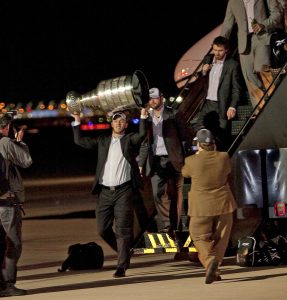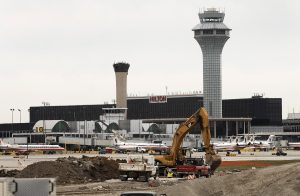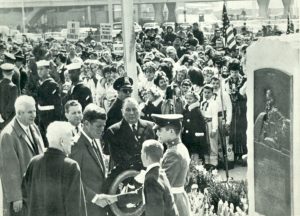BICENTENNIAL 2018: O’Hare Airport: For many, the place to reunite with the ones you love best
By Marni Pyke — May 31, 2018

O’Hare International Airport’s iconic Terminal 1 features glass and steel architecture. (Daily Herald photo by Bob Chwedyk)
It took just seven years for O’Hare International Airport to rise from an unassuming, former aircraft factory to the world’s busiest airport in 1962.
Since then, the Midwest aviation hub has witnessed history and sparked an economic boom in the region; but for many across Illinois, it’s the place to reunite with the ones you love best.
“Creating O’Hare was a marvelously foresighted decision by the city of Chicago,” aviation expert Joseph Schwieterman said.
Chicago leaders chose Orchard Field, where the Douglas Aircraft Co. was building fighter planes, as the site for a second airport to relieve busy Midway International Airport in 1945.
The facility got its name in 1949 from heroic World War II pilot Edward “Butch” O’Hare and opened for commercial traffic in 1955. The main terminal building and a parking lot were completed in 1961 and in 1963 President John F. Kennedy dedicated the airport.
“There is no other airport in the world which serves so many people and so many planes,” Kennedy said.
O’Hare can be credited with generating a commercial boom in northwest Chicago and the surrounding suburbs that includes industrial parks, hotels and restaurants, freight operations and transportation services.

The Chicago Blackhawks Jonathan Toews carries the Stanley Cup off the team plane after arriving at O’Hare International Airport June 10, 2010, from Philadelphia, where the team won the championship. (The Associated Press)
An estimated 450,000 jobs in the region are linked to O’Hare and its economic impact is $38 billion, according to the Chicago Department of Aviation. An extension of Route 390/Elgin-O’Hare Expressway to the airport and a ring road (I-490) on its western edge are projected to create up to 65,000 new direct and indirect jobs in the region.
O’Hare ranks as the country’s second busiest airport, with 867,635 arrivals and departures in 2016, compared to Hartsfield-Jackson Atlanta International Airport with 898,356.
But along with being a financial and transportation asset, O’Hare has an emotional connection with Illinoisans.
Over the years, the airport has witnessed heartbreak as when American Airlines Flight 191 crashed minutes after takeoff near Des Plaines in 1979.
It’s seen emotional farewells as soldiers deployed to Vietnam, Afghanistan and Iraq, and joyful reunions as they returned.
And in January 2017, it saw protests over a travel ban enacted by the White House on seven predominantly Muslim nations.
Famous fliers have taxied on the tarmac from President Barack Obama aboard Air Force One to sports teams raising trophies such as the 1985 Chicago Bears, 2005 White Sox, 2013 Blackhawks and 2016 Chicago Cubs.
Back in 1963, Kennedy hoped the government and airlines, “will continue to work as hard as they can to make sure that the noise from these jets which take us in and out do not disturb the lives of … people whose homes are in the immediate area.”
His words were prescient as noise is the crux of the love-hate relationship neighborhoods around O’Hare have had with the behemoth. Neighbors appreciate the fact that the airport creates jobs, but loathe the din of jets over their homes. Since 1995, more than 10,900 homes have been soundproofed but concerns about noise continue to date.
The airport was a trendsetter over the years with the iconic steel and glass of Terminal 1 designed by Helmut Jahn and the transcendent “Sky’s the Limit” light sculpture between Concourses B and C. Other unique features include a soothing hydroponic garden, a replica of a World War II fighter plane and a yoga room.
“When O’Hare opened it was rivaled only by JFK (International Airport in New York) as an aviation showpiece that pointed the way to the future,” said Schwieterman, a DePaul University professor, “(with) the double-deck roadway, multiple-terminal design, the room for expansion in the footprint.”
In its most recent metamorphosis, O’Hare is shifting to a parallel runway system instead of relying on diagonals. The sixth and final parallel is scheduled to be completed in fall 2020.

O’Hare International Airport is undergoing a shift to a new parallel runway system. Construction will wrap up with the sixth parallel in 2020. (Daily Herald File Photo)
As its next act, the city of Chicago is pursuing an O’Hare 21 plan. Elements include “a new global terminal, more gate frontage, more space for passenger amenities and other improvements to increase efficiency of growing airport operations,” CDA Communications Deputy Commissioner Lauren Huffman said.
“Aging terminals will be redeveloped and a new global terminal will double O’Hare’s capacity for serving international passengers, allowing arriving international passengers to exit faster and connect to other flights with greater ease.”
The plan also includes three new or redeveloped hotels and additional gates.
“Getting around the airport will be faster, more convenient and efficient. Customer service will be improved with new technology, amenities and more space to relax,” Huffman said. “Over the next decade, these investments will ensure that O’Hare is equipped for growth and to maintain its status as a top destination and choice hub for passengers around the world.”
Marni Pyke of the Daily Herald can be reached at mpyke@dailyherald.com.
Editor’s note: The weekly Illinois Bicentennial series is brought to you by the Illinois Associated Press Media Editors and Illinois Press Association. More than 20 newspapers are creating stories about the state’s history, places and key moments in advance of the Bicentennial on Dec. 3, 2018. Stories published up to this date can be found at 200illinois.com.
–BICENTENNIAL 2018: O’Hare Airport: For many, the place to reunite with the ones you love best–








